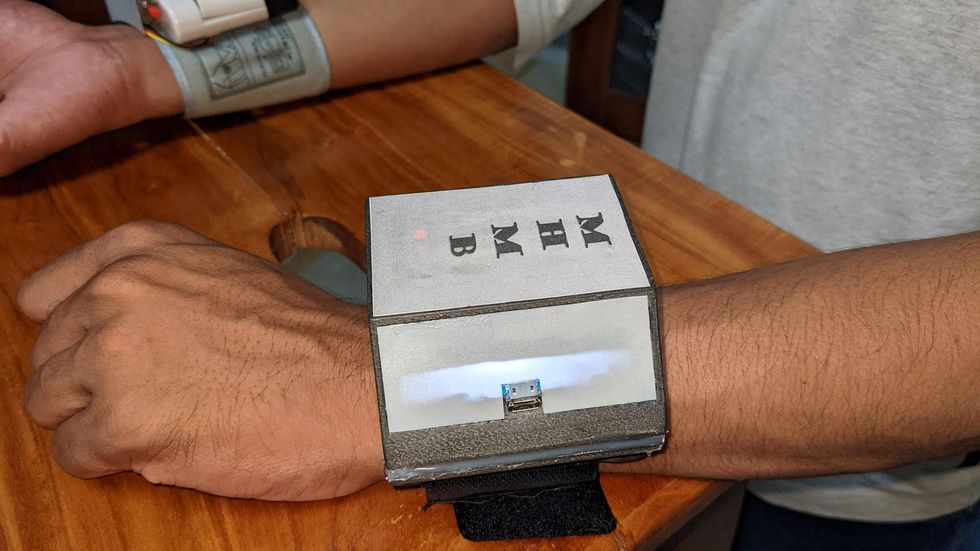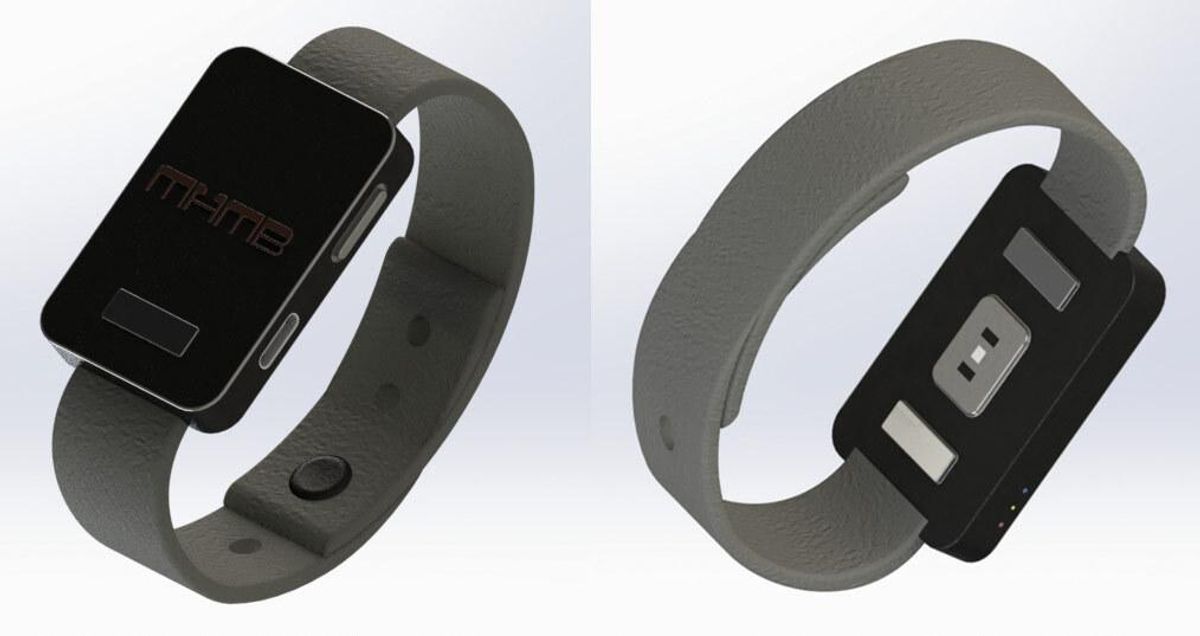The health-monitoring bracelet that Pramuka Sooriyapatabandige designed can measure vital signs such as heart rate, skin temperature, blood pressure, and blood oxygen saturation. What’s more, the device should be inexpensive to manufacture and could be made in his native country of Sri Lanka, where access to health care can be difficult. The bracelet recently won first place in the IEEE Telehealth Virtual Pitch Competition student category.
The IEEE student member says he was inspired to develop the multipurpose health-monitoring bracelet (MHMB) because noncommunicable, chronic diseases such as cancer and heart disease account for 70 percent of deaths worldwide, and more than three-quarters of them occur in developing countries including Sri Lanka. The South Asian country is in the midst of an economic crisis, and its health care system is struggling, according to a U.N. report.
“When I started this research project, I did not have a clear idea of the problems with health care,” says Sooriyapatabandige, who earned a bachelor’s degree in electrical and electronics engineering this year from the University of Jaffna, in Thirunelvely, Sri Lanka. “After participating in the competition, I got access to so much material on remote health monitoring. I got to see how much work is being carried out, the types of research going on, and the trends. Developing countries barely make use of any of this information, and I think there’s a lot we can do in this field.”
The advantages of a remote system
People with chronic conditions such as heart disease and cancer have their vital signs checked regularly. But scheduling an examination with a doctor can be challenging, especially for people living in developing countries and other areas where there’s a shortage of health care professionals. Appointments can be difficult to get, and travel to a medical facility can take a long time. One solution is to use telemedicine to monitor patients remotely.
Clinics make up the backbone of Sri Lanka’s health care system. To avoid overcrowding, people may visit a clinic only on the day they have been assigned, Sooriyapatabandige says. If monitoring vital signs could be done remotely, he says, it would reduce the number of people at the facilities and free up the medical staff to treat those with more serious conditions.
“Strengthening primary health care with a comprehensive, community-based, and family-focused technology solution could be the key for addressing the existing health issues in Sri Lanka,” he says. “Home-based monitoring of essential health parameters is important, and current technologies can address the need.”
A cloud-based system that collects real-time data

The MHMB is designed to be part of a centralized, remote monitoring system. The battery-powered wearable includes sensors to measure vital signs. It uses photoplethysmography to measure heart rate and includes the capability to obtain single-lead measurements. The bracelet doesn’t have a display and requires only minimal attention from the user.
It cost about US $100 to develop the prototype, Sooriyapatabandige says.
The wearable connects to the cloud via Wi-Fi. Medical staff can access the patient’s data from the monitoring system or from an app. Patients can download the app on their phone to view the history of their readings.
“Home-based monitoring of essential health parameters is important, and current technologies can address the need.”
The bracelet also can be connected to blood pressure monitors, glucometers, and other medical devices. Sooriyapatabandige says that because the MHMB can connect to the tools, the bracelet’s capabilities are not limited to only the measurements that can be made at the wrist. It also makes the bracelet a central node, or hub, for the remote patient-monitoring system, which provides connectivity so other devices can access the platform.
The ability to link to the other tools is not offered by any other such wearable, Sooriyapatabandige says.
The system can be used in mass-casualty scenarios, he says, such as checking natural disaster victims’ vitals, as well as other situations in which there are significant challenges in scaling up medical services.
Clinical trials and a possible patent
Sooriyapatabandige didn’t develop the MHMB on his own. He worked on the design with classmate Nilojkanth Loganathan and the project’s supervisor, Ragupathyraj Valluvan, a lecturer in electrical and electronic engineering at the University of Jaffna. Sooriyapatabandige also had assistance from Rajendra Surenthirakumaran , dean of the university’s medicine faculty, and Sivasothy Shanmugalingam, founder of DotsHook, a telecommunications company in Brittany, France.
Sooriyapatabandige and the team are now developing a version of the bracelet for clinical trials. The university is filing a patent application with the National Intellectual Property Office of Sri Lanka.
Sooriyapatabandige says he plans to continue working in the biomedical field. He is looking into Ph.D. programs in embedded systems development, primarily those related to biomedical applications.
Looking for innovations in telehealth
The IEEE Standards Association (IEEE SA) held the pitch competition this year to seek out telehealth innovations. The contest was overseen by the IEEE SA Healthcare and Life Sciences Practice and the IEEE SA Transforming the Telehealth Paradigm Industry Connections program.
Entries had to be affordable and easy to use, and they had to protect users’ privacy. They also needed to use inexpensive materials, be scalable, operate with other medical applications, and comply with regional regulatory policies. Submissions came from more than 106 countries.
After winning the competition, Sooriyapatabandige is set to work with a local IEEE Special Interest Group on Humanitarian Technology to test the prototype.
He was a guest speaker in Season 4’s third episode of theIEEE Re-Think Health podcast. In addition, he presented his project at the IEEE Standards Association’s Transforming the Telehealth Paradigm event.
“New and improved methods, such as remote patient monitoring, bring about numerous advantages and benefits,” he says. “In order to ensure that most of the world gets to enjoy these benefits, it is essential to encourage more people and organizations to get involved in these initiatives. Our project and the IEEE SA Telehealth competition are both focused on achieving the most out of these technologies as early as possible and making them available to everyone everywhere.”
The benefits of IEEE membership
Sooriyapatabandige joined IEEE in 2018. He served as secretary of his university’s IEEE Robotics and Automation Society’s student chapter. He organized several events and collaborated with other IEEE societies.
Those opportunities, he says, helped him enhance his leadership and organizational skills: “I got to experience aspects of the different IEEE societies and then identify what was best for me and where my passion lies. IEEE also gave me numerous opportunities, including this competition, to enhance my knowledge and skills as well as to network with professionals and experts.”
Kathy Pretz is editor in chief for The Institute, which covers all aspects of IEEE, its members, and the technology they're involved in. She has a bachelor's degree in applied communication from Rider University, in Lawrenceville, N.J., and holds a master's degree in corporate and public communication from Monmouth University, in West Long Branch, N.J.



